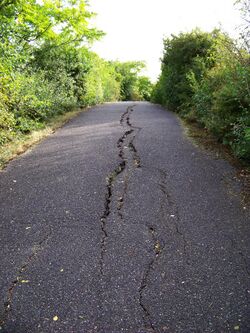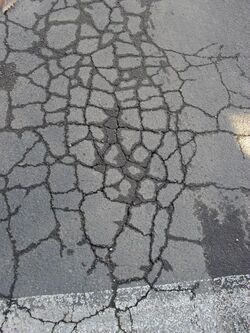Engineering:Pavement cracking
From HandWiki
Pavement crack refers to a variety of types of pavement distresses that occur on the surface of pavements. Different types of pavements develop different cracks. Type of cracking is also correlated with the type of climate and traffic.[1][2] Sometimes the cracks are aggregated using an index such as Crack index, and sometimes they are merged with other distresses and are reported using Pavement Condition Index.[3]
Types of cracking
Some of the most important types of crack are as follows:[1][4]
- Crocodile cracking, also known as alligator cracking and fatigue cracking
- Block cracking (caused by shrinkage of asphalt)
- Longitudinal cracking—wheel path
- Longitudinal cracking—non-wheel path
- Transverse cracking
- Reflection cracking at joints
- Edge cracking (caused because of poor drainage or lack of support at the edge)
- Slippage cracking
References
- ↑ 1.0 1.1 Piryonesi, Sayed Madeh (November 2019). The Application of Data Analytics to Asset Management: Deterioration and Climate Change Adaptation in Ontario Roads (PDF) (PhD). University of Toronto. Archived (PDF) from the original on 2022-12-04. Retrieved 2022-12-15.
- ↑ "Distress Identification Manual for the Long-Term Pavement Performance Program". Federal Highway Administration. June 2003. https://www.fhwa.dot.gov/publications/research/infrastructure/pavements/ltpp/reports/03031/03031.pdf.
- ↑ Piryonesi, S. Madeh; El-Diraby, Tamer E. (March 2020). "Data Analytics in Asset Management: Cost-Effective Prediction of the Pavement Condition Index". Journal of Infrastructure Systems (American Society of Civil Engineers) 26 (1). doi:10.1061/(ASCE)IS.1943-555X.0000512.
- ↑ "Standard Practice for Roads and Parking Lots Pavement Condition Index Surveys (Designation: D6433-07)". ASTM International. 2015. https://pages.mtu.edu/~balkire/CE5403/ASTMD6433.pdf.
 |



